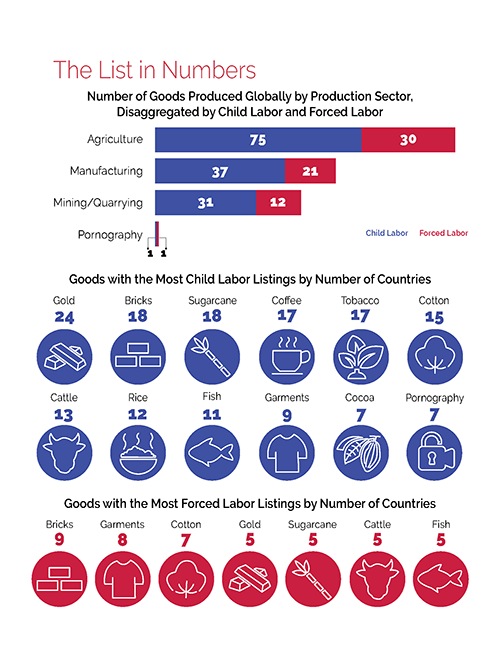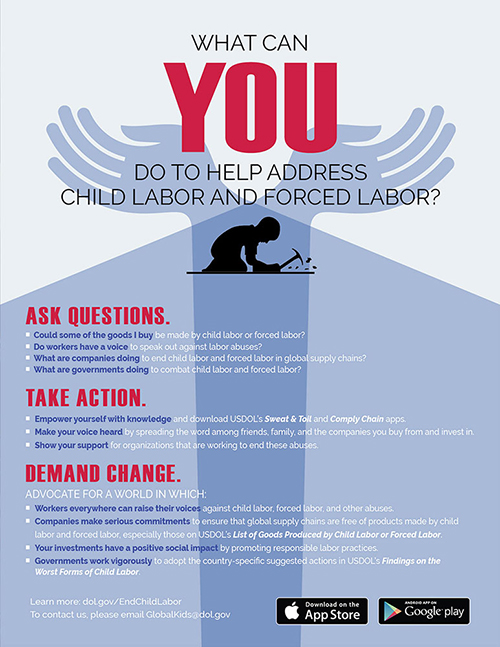List of Goods Produced by Child Labor or Forced Labor
The Bureau of International Labor Affairs (ILAB) maintains a list of goods and their source countries which it has reason to believe are produced by child labor or forced labor in violation of international standards, as required under the Trafficking Victims Protection Reauthorization Act (TVPRA) of 2005 and subsequent reauthorizations. The List of Goods Produced by Child Labor or Forced Labor comprises 159 goods from 78 countries and areas, as of September 28, 2022.
ILAB maintains the List primarily to raise public awareness about forced labor and child labor around the world and to promote efforts to combat them; it is not intended to be punitive, but rather to serve as a catalyst for more strategic and focused coordination and collaboration among those working to address these problems.
Publication of the List has resulted in new opportunities for ILAB to engage with foreign governments to combat forced labor and child labor. It is also a valuable resource for researchers, advocacy organizations and companies wishing to carry out risk assessments and engage in due diligence on labor rights in their supply chains.
The countries on the List span every region of the world. The most common agricultural goods listed are sugarcane, cotton, coffee, tobacco, cattle, rice, and fish. In the manufacturing sector, bricks, garments, textiles, footwear, carpets, and fireworks appear most frequently. In mined or quarried goods, gold, coal and diamonds are most common.
ILAB published the initial TVPRA List in 2009 and updated it annually through 2014, following a set of procedural guidelines that were the product of an intensive public consultation process. ILAB now updates and publishes the List every other year, pursuant to changes in the law.
Procedural Guidelines
On January 25, 2024, ILAB's Office of Child Labor, Forced Labor, and Human Trafficking published Procedural Guidelines for the development and maintenance of the List of Goods from countries produced by child labor or forced labor in violation of international standards.
| Country/Area Sort descending | Good | Exploitation Type |
|---|---|---|
| Cambodia | Child Labor | |
| Cambodia | Child Labor | |
| Cambodia | Child Labor | |
| Cambodia | Child Labor | |
| Cambodia | Child Labor | |
| Cambodia | Child Labor | |
| Cambodia | There is evidence that children between the ages of 5 and 14 engage in the production of bovines in Cambodia. In Cambodia, bovines are primarily used for domestic consumption and for farming purposes, and are raised by approximately 1.4 million smallholders primarily located in provinces bordering the Mekong River, with a heavy concentration found in the southern rice-producing provinces. Based on analysis of the 2016 Cambodian Socio-Economic Survey, an estimated 59,693 children are involved in child labor in the production of bovines. The release of this survey demonstrates the Government of Cambodia’s commitment to addressing child labor and its acknowledgment that data collection is vital to the design and implementation of sound policies and programs. |
Child Labor |
| Cambodia | Child Labor | |
| Cambodia | There are reports that children ages 5 to 17 produce sugarcane in Cambodia. Child labor in the sugarcane sector occurs on both commercial plantations and smallholder farms. Children from families that have lost land through concessions to sugar companies are particularly vulnerable to exploitative labor on plantations. According to international organizations, NGOs, and media reports, child labor in the Cambodian sugarcane sector is a widespread concern, with numerous incidents reported across the country, including reports of hundreds of children cutting cane on plantations in the Koh Kong province. Children laboring in the sugarcane fields often work long hours under the hot sun and report difficulty breathing, headaches, and dizziness as a result. Child workers in this sector perform hazardous tasks such as carrying heavy bundles of sugarcane, using dangerous tools, and spraying toxic pesticides. Many children incur injuries on the job, including skin infections and cuts from sharp cane leaves or knives. |
Child Labor |
| Cambodia | There are reports that children are forced to produce bricks in Cambodia. According to international researchers and NGOs, numerous incidents of forced child labor have been reported in Cambodia. Reports estimate over 9.3 percent of brick workers are children. However, with upwards of tens of thousands of workers employed at brick kilns and the casual nature of work in brick kilns, this number is likely higher. A cycle of multi-generational debt bondage is created when adults are unable to pay back the high interest charged on loans offered by brick kiln owners and are forced to pass along outstanding debts to their children. Children either inherit or are born into debt bondage and are threatened with arrest or are forced to pay additional debt if they try to leave the brick kiln without repaying their debts in full. |
Child Labor, Forced Labor |
your hand? Download ILAB's Sweat & Toil App today!
Are you a company looking to fight child labor and forced labor in supply
chains?





